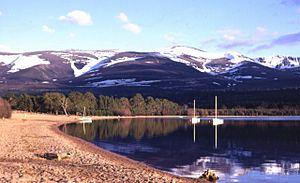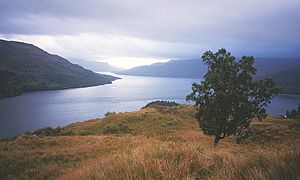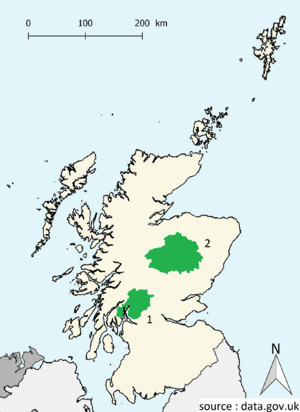National parks of Scotland facts for kids
The national parks of Scotland (Pàirc Nàiseanta in Scottish Gaelic) are special areas of amazing landscape. They are managed to protect their natural beauty and environment. Some types of building or changes are limited here to keep the landscape safe.
Scotland currently has two national parks:
- Loch Lomond and The Trossachs National Park, started in 2002.
- Cairngorms National Park, started in 2003.
Unlike national parks in many other countries, Scotland's parks are not empty lands owned by the government. Most of the land belongs to private owners, including groups like the National Trust for Scotland. People still live and work in these parks. Even though the landscapes look "wild," they are not true wilderness. Humans have used and shaped these lands for thousands of years.
Just like parks in England and Wales, Scotland's national parks are "managed landscapes." This means they are looked after to keep their special character. They are one of many ways Scotland protects its beautiful places.
Everyone in Scotland has a right to access most land and water. This is thanks to the Land Reform (Scotland) Act 2003. This right lets people enjoy activities like walking, camping, cycling, canoeing, swimming, and climbing. This rule applies everywhere, not just in national parks. People must use this right responsibly, following the Scottish Outdoor Access Code.
Contents
How Scotland's National Parks Started
The idea of national parks first came from the United States in the 1860s. There, parks like Yosemite were made to protect wild areas. John Muir, who was born in Scotland, was a key person in creating these US national parks. He also helped start the wider conservation movement. Many countries later created parks to protect their wilderness.
However, Scotland doesn't have truly wild areas. Thousands of years of human activity have changed the landscape. Farming, cutting down trees, too many sheep and deer, and planting many new trees (especially conifers) have all shaped the land. This means Scotland's landscapes are "semi-natural," not untouched wilderness.
Even so, people in Scotland wanted to protect beautiful or remote areas. They also wanted to encourage public access. In 1931, a group led by Christopher Addison suggested a national park in the Cairngorms. They also suggested parks for England and Wales.
After World War II, the government passed a law in 1949. This led to 10 national parks being created in England and Wales. But no parks were made in Scotland at that time. A committee then looked into national parks for Scotland. In 1945, they suggested five areas for parks:
- Loch Lomond & the Trossachs
- The Cairngorms
- Glen Coe-Ben Nevis-Black Mount
- Wester Ross
- Glen Strathfarrar-Glen Affric-Glen Cannich
These areas became "National Park Direction Areas." This meant the government could check planning decisions there. But they were not full national parks. Later, in 1981, these areas became National Scenic Areas. There are now 40 of these. They offer some protection, but they don't have their own park authorities.
In 1990, another report suggested four areas should become national parks. These were:
- Loch Lomond & the Trossachs
- The Cairngorms
- Glen Coe-Ben Nevis-Black Mount
- Wester Ross
Despite all these suggestions, nothing happened until the Scottish Parliament was set up in 1999. The two current parks were officially created under the National Parks (Scotland) Act 2000. This was one of the first laws passed by the new Parliament.
Since then, no new parks were created for a while. However, the Cairngorms National Park was made bigger in 2010.
New Park Ideas
In 2005, the Scottish government wanted to create Scotland's first park for the coast and sea. They looked at five possible places. But no marine park has been created yet.
In 2013, a group called the Scottish Campaign for National Parks suggested seven more areas. They thought these places would be good for national parks:
- Harris
- Wester Ross
- Glen Affric
- Mull and the Small Isles (as a marine park)
- Ben Nevis, Glen Coe and the Black Mount
- Galloway
- Cheviot Hills
In 2021, the Scottish government promised to create at least one more national park by 2026. Local groups and councils were asked to suggest areas. As of late 2023, many areas were thinking about applying, including:
- Galloway
- Scottish Borders
- Tay Forest
- Ben Nevis and Lochaber
- Eilean a' Cheo (Skye and Raasay)
- Affric to Alladale
- Glen Affric
- Lammermuir Hills
- Largo Bay
- Loch Awe
In July 2024, the Scottish government announced that Galloway would become the country's third national park!
How National Parks Are Run
Each national park in Scotland is managed by a special group called a national park authority. The law says that national parks in Scotland have four main goals:
- To protect and improve the natural and cultural heritage of the area.
- To encourage using the area's natural resources in a way that can last (sustainable use).
- To help people understand and enjoy the special qualities of the area, including for fun activities.
- To help the communities in the area grow in a way that can last (sustainable economic and social development).
The first two goals are similar to parks in England and Wales. But Scottish parks have two extra goals (numbers 3 and 4). The park authority's main job is to make sure all these goals are met together.
If there's a big problem where goals can't all be met at once, the first goal (protecting nature and heritage) is usually given more importance. This is known as the Sandford Principle.
A key job of the park authority is dealing with building plans. The Loch Lomond and The Trossachs National Park is a full planning authority. This means it makes all the planning decisions. The Cairngorms National Park can check planning decisions made by local councils. It can step in if they don't fit with the park's goals. Park authorities also manage public access to the countryside.
Besides planning and access, park authorities have a lot of freedom. They can buy land, make rules, give grants, offer advice, and do research. All these actions help them achieve the four goals.
Each national park authority is run by a board. This board includes:
- Members chosen by people living in the park.
- Members from the local councils that have land inside the park.
- Members chosen by the Scottish government.
The Cairngorms National Park board has 19 members. The Loch Lomond and The Trossachs National Park board has 17 members.
| Who is on the National Park Boards | ||
|---|---|---|
| Members | Cairngorms | Loch Lomond and The Trossachs |
| Elected by local people | 5 | 5 |
| Chosen by local councils | 7 (2 from The Highland Council, 2 from Aberdeenshire Council; 1 from Moray Council, 1 from Angus Council, 1 from Perth and Kinross Council) | 6 (2 from Stirling Council, 2 from Argyll and Bute Council; 1 from West Dunbartonshire Council, 1 from Perth and Kinross Council) |
| Chosen by Scottish Government | 7 | 6 |
| Total | 19 | 17 |
List of Scottish National Parks
|




